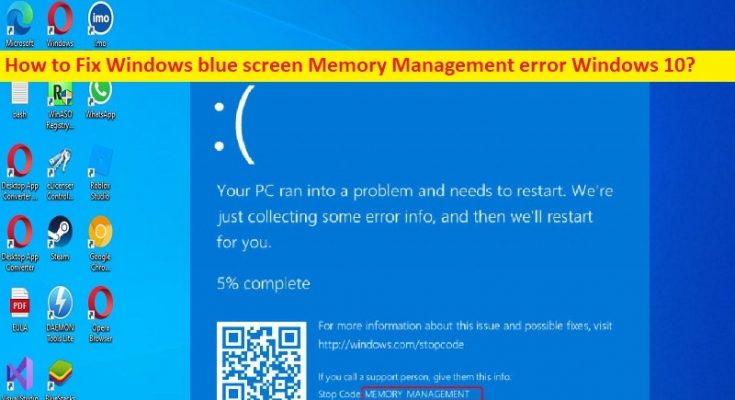What is ‘Windows blue screen Memory Management error’ in Windows 10?
If you are experiencing Windows blue screen Memory Management error and looking for ways to fix, then you are in right-place for the solution. You are provided here with easy steps/methods to resolve the issue. Let’s starts the discussion.
‘Windows blue screen Memory Management error’:
It is common Windows Problem considered as Blue Screen of Death (BSOD) error. This error is appeared with message saying ‘Your PC ran into a problem and need to restart. We’re just collecting some error info, and then we’ll restart for you’ along with Windows Stop Memory Management or others. This BSOD error is usually occurred in the middle of your work in computer or when you start/restart Windows computer.
If you are not aware, Memory Management is the process that manages memory usage in Windows computer. It keeps track of every byte of memory in computer, and whether it is free or being used. It decides how much memory to allocate to certain processes and when to give it to them. It also frees up memory when you close a program by marking it as available to be used by something else.
However, several users reported they faced Windows blue screen Memory Management error when they run highly demanding processes such as complex games, VR games, watching 4k live streams, etc. There could be several reasons behind the issue including corruption in system files or registry, malware or viruses infections in computer, outdated Windows OS, issue with RAM or memory, and other issues. Let’s go for the solution.
How to fix Windows blue screen Memory Management error in Windows 10?
Method 1: Fix Windows blue screen Memory Management error with ‘PC Repair Tool’
‘PC Repair Tool’ is easy & quick way to find and fix BSOD errors, DLL errors, EXE errors, problems with programs/applications, malware or viruses infections in computer, system files or registry issues, and other system issues with just few clicks.
Method 2: Run SFC scan
You can run SFC scan in computer to repair corruption in system files in order to fix the issue.
Step 1: Type ‘cmd’ in Windows Search Box and press ‘SHIFT + ENTER’ keys on keyboard to open ‘Command Prompt as Administrator’
Step 2: Type ‘sfc /scannow’ command and hit ‘Enter’ key to execute. Once executed, restart your computer and check if the issue is resolved.
Method 3: Run Windows Memory Diagnostic tool
Step 1: Open ‘Windows Memory Diagnostic’ tool in Windows computer via Windows Search Box
Step 2: Select ‘Restart now and check for problems’ and wait to finish scanning and repairing process and once finished, check if the issue is resolved.
Method 4: Update device drivers
Updating all necessary device drivers to latest & compatible version can fix the issue. You can update all Windows drivers including sound card driver, graphics card driver and all other drivers using Automatic Driver Update Tool. You can get this tool through button/link below.
Method 5: Update Windows OS
Updating Windows OS to latest version can resolve the issue.
Step 1: Open ‘Settings’ app in Windows PC and go to ‘Update & Security > Windows Update’ and click ‘Check for updates’ button
Step 2: Download and install all available updates and once updated, restart your computer and check if the issue is resolved.
Method 6: Clean your temporary files and folders

Step 1: Open ‘Disk Cleanup’ tool in Windows PC via Windows Search Box
Step 2: Select your Windows installation drive like ‘C: drive’, and hit ‘Ok’ button and perform disk cleanup to clean temporary files and folders. Once done, check if the issue is resolved.
Method 7: Run CHKDSK scan
Step 1: Open ‘Command Prompt as Administrator’ using ‘Method 2’
Step 2: Type ‘chkdsk c: /f’ command and hit ‘Enter’ key to execute. Once executed, restart your computer and check if the issue is resolved.
Method 8: Uninstall the problematic software
If the issue is started occurring after installation of a software or problematic software installed, you can uninstall it in order to fix. To do so, you need to open ‘Control Panel’ in Windows PC via Windows Search Box and go to ‘Uninstall a program > Programs & features’, find and right-click on problematic applications, and select ‘Uninstall’ to uninstall it and then restart your computer, and check if the issue is resolved.
Method 9: Increase virtual memory manually

Step 1: Open ‘Advanced System Settings’ in Windows PC via Windows Search Box
Step 2: Click ‘Advanced’ tab ad click ‘Settings’ under ‘Performance’ panel
Step 3: Click ‘Advanced’ tab again, go to ‘Virtual Memory’ panel and select ‘Change’
Step 4: Deselect ‘Automatically manage paging file size for all drives’ checkbox and click ‘Drive (Volume Label)’ and choose ‘Custom Size’
Step 5: Add a new size in MB and then select ‘Set’ and hit ‘Ok’ to save the changes. Once done, restart your computer and check if the issue is resolved.
Method 10: Perform System Restore
If the issue is still persist, you can run System Restore in computer in order to fix.
Step 1: Press ‘Windows + R’ keys on keyboard, type ‘rstrui’ in ‘Run’ window and hit ‘Ok’ button to open ‘System Restore’ app
Step 2: Click ‘Next’, select a valid restore point according to date & time when there was no issue at all in computer, and then click ‘Next > Finish’ to start restoring process and once finished, check if the issue is resolved.
Conclusion
I am sure this article helped you on How to fix Windows blue screen Memory Management error in Windows 10 with easy ways. You can read & follow our instructions to do so. That’s all. For any suggestions or queries, please write on comment box below.



